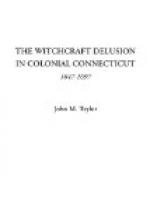“The Court may please to consider also how farr these proceedings do put a difficulty on any further tryal of this woman.”
All honor to Joseph Elliot, Timothy Woodbridge and their ministerial associates; to Samuel Willis, Pitkin and Nath. Stanly, level-headed men of affairs, all friends of the court called upon for advice and counsel—who gave it in full scriptural measure.[H]
[Footnote H: Mercy Disborough was pardoned, as the records show that she was living in 1707.]
CHAPTER VIII
“Old Matthew Maule was executed for the crime of witchcraft. He was one of the martyrs to that terrible delusion, which should teach us, among its other morals, that the influential classes, and those who take upon themselves to be leaders of the people, are fully liable to all the passionate error that has ever characterized the maddest mob.”
“Clergymen, judges, statesmen—the wisest, calmest, holiest persons of their day—stood in the inner circle round about the gallows, loudest to applaud the work of blood, latest to confess themselves miserably deceived.”
“This old reprobate was one of the sufferers when Cotton Mather, and his brother ministers, and the learned judges, and other wise men, and Sir William Phipps, the sagacious governor, made such laudable efforts to weaken the great enemy of souls by sending a multitude of his adherents up the rocky pathway of Gallows Hill.” The House of the Seven Gables (20: 225), HAWTHORNE.
“Then, too, the belief in witchcraft was general. Striking coincidences, personal eccentricities, unusual events and mysterious diseases seemed to find an easy explanation in an unholy compact with the devil. A witticism attributed to Judge Sewall, one of the judges in these trials, may help us to understand the common panic: ’We know who’s who but not which is witch.’ That was the difficulty. At a time when every one believed in witchcraft it was easy to suspect one’s neighbor. It was a characteristic superstition of the century and should be classed with the barbarous punishments and religious intolerance of the age.” N.E. Hist. Towns.—LATIMER’S—Salem (150).
Multiplication of these witchcraft testimonies, quaint and curious, vulgar and commonplace, evil and pathetic, voices all of a strange superstition, understandable only as through them alone can one gain a clear perspective of the spirit of the time and place, would prove wearisome. They may well remain in the ancient records until they find publicity in detail in some accurate and complete history of the beginnings of the commonwealth—including this strange chapter in its unique history.
It will, however, serve a present necessary purpose, and lead to a more exact conception of the reign of unreason, if glimpses be taken here and there of a few of the statements made on oath in some of the other cases.




